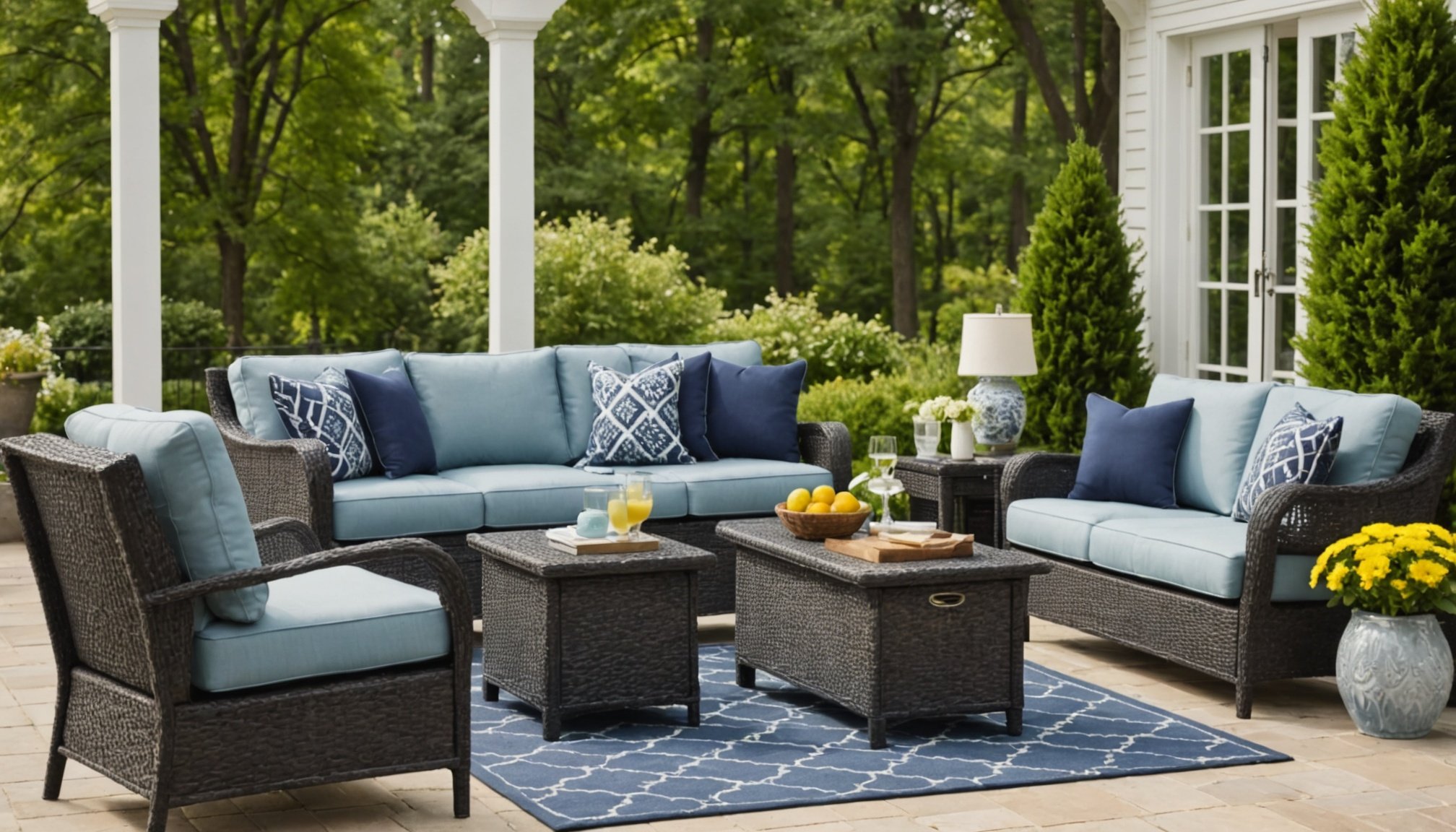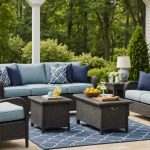Choosing the right outdoor furniture can transform your patio, garden, or balcony into a cozy retreat or an elegant entertaining space. With countless options available, from modern to traditional styles, finding pieces that blend comfort and aesthetics is essential. This article will guide you through various factors to consider when selecting outdoor furniture, ensuring you create an inviting atmosphere that reflects your personal style.
Understanding Your Outdoor Space
Before diving into specific furniture choices, it’s crucial to understand the outdoor space you have available. Assess the layout of your patio, garden, or balcony. Consider the dimensions, existing landscaping, and how you envision using the area. Is it for quiet relaxation, lively gatherings, or perhaps both?
Have you seen this : What steps should I take to soundproof a home office for remote work?
Once you grasp your space’s layout, think about the orientation. Is it shaded by trees, exposed to the sun, or partially sheltered? The climate will impact your furniture choice significantly. For example, if your area receives ample sunlight, you might want to prioritize materials that withstand fading. Moreover, consider the ground surface—whether it’s concrete, grass, or tiles—since this can influence the type of furniture that’s suitable.
Next, consider your style preferences. Are you drawn to a sleek, modern aesthetic, or do you prefer classic, rustic designs? This decision will guide your choices and help you select furniture that aligns with your taste. Remember, your outdoor space should feel like an extension of your home, reflecting your unique style while ensuring comfort.
Also read : What are the most cost-effective ways to upgrade my bathroom?
Selecting Comfortable and Durable Materials
After understanding your space and style, the next step is choosing the right materials for your outdoor furniture. Comfort starts with good design, but the material plays a critical role in your overall experience. Popular materials include wood, metal, and synthetic fibers, each offering distinct benefits.
Wood is a classic choice known for its warmth and natural beauty. Teak, eucalyptus, and cedar are excellent options due to their durability and resistance to weather elements. However, wooden furniture often requires regular maintenance, such as sealing or staining, to maintain its appearance and longevity.
Metal furniture, typically made of aluminum or wrought iron, provides a sturdy option that can withstand various weather conditions. Aluminum is lightweight, rust-resistant, and easy to move, making it an ideal choice for flexible outdoor spaces. Wrought iron, while heavier and more robust, can add a timeless elegance but may require some maintenance to prevent rust.
On the other hand, synthetic materials, such as resin wicker or high-density polyethylene (HDPE), have gained popularity for their durability and low maintenance. These materials can mimic the look of natural fibers while resisting fading, cracking, and peeling. Additionally, they are often lightweight and easy to clean, making them a practical choice for busy outdoor lifestyles.
Ultimately, your choice should balance comfort, durability, and maintenance requirements. Selecting high-quality materials ensures your outdoor furniture remains inviting and stylish for years to come.
Emphasizing Comfort Through Design
Comfort is paramount when selecting outdoor furniture. You want to ensure that your choices invite you to sit down, relax, and enjoy your outdoor space. First, consider the design of the furniture pieces. Look for chairs, sofas, and loungers with ergonomic shapes that support your body. Test them out if possible—spending a few minutes in a chair can reveal much about its comfort level.
Next, consider cushioning. Outdoor cushions should be made from weather-resistant materials, such as acrylic or polyester, that resist fading and mold. Look for thick, supportive cushions covered with durable, easy-to-clean fabric. Firmness is essential; while you want softness for comfort, cushions that are too plush can cause discomfort over time. Therefore, striking the right balance is crucial for your outdoor seating.
Additionally, keep in mind the height and scale of the furniture in relation to your space. If you have a small area, opt for streamlined, smaller pieces that don’t overpower the space. Conversely, if you have a vast patio, larger sectional sofas can create a cozy gathering area without feeling cramped.
Lastly, consider how you will arrange your furniture. Grouping seating areas can enhance comfort and encourage conversation. A well-planned layout can significantly impact how inviting your outdoor space feels, so take the time to visualize and experiment with different arrangements.
Incorporating Style and Aesthetics
While comfort is essential, the aesthetic appeal of your outdoor furniture should not be overlooked. Your outdoor space should be a reflection of your personality and style. To achieve a harmonious look, consider the color palette of your furniture. Choose colors that complement your home’s exterior and any existing landscaping. Neutral tones offer versatility, while bold colors can create a lively atmosphere.
Additionally, think about design elements such as patterns and textures. Mixing materials, such as combining metal frames with wooden tabletops or colorful cushions, can add depth and interest to your space. However, be cautious not to overwhelm your area with too many competing patterns. Aim for a cohesive look that ties all elements together, creating a seamless flow between comfort and style.
Accessories also play a vital role in enhancing the aesthetic appeal of your outdoor area. Consider adding throws, pillows, or outdoor rugs that add color, texture, and comfort. Decorative elements like lanterns, centerpieces, or outdoor art can further personalize your space, making it feel inviting and unique.
Finally, ensure that your furniture complements any existing structures, such as pergolas or awnings. This integration creates a cohesive outdoor environment, transforming an ordinary patio into a stylish retreat.
Maintaining Your Outdoor Furniture
To ensure your outdoor furniture remains comfortable and stylish, implementing a proper maintenance routine is crucial. Different materials require varying levels of care, so understanding these needs can prolong the life of your investment.
For wooden furniture, regular cleaning and sealing are vital. Use a soft brush or cloth to remove dirt and debris, and apply a protective sealant at least once a year to prevent water damage and fading. In case of scratches or dents, you can sand the affected areas and re-stain them to maintain a uniform appearance.
With metal furniture, it’s essential to check for rust or corrosion, especially if you live in a humid climate. Occasionally wash the surfaces with soap and water, and apply a protective spray if you notice any signs of wear. For synthetic materials, a simple wipe down with a damp cloth will usually suffice. However, avoid harsh chemicals that may damage the finish.
Cushions and fabric should also be cared for properly. Regularly shake out and vacuum cushions to remove dust and debris. Most outdoor fabrics are machine washable, but always check the care label for specific instructions. When not in use, consider storing cushions indoors or using protective covers to prolong their life.
By establishing a consistent maintenance routine, you’ll ensure your outdoor furniture remains inviting and stylish, allowing you to enjoy your space for many years.
Choosing the right outdoor furniture involves considering comfort, style, and maintenance requirements. By understanding your outdoor space, selecting durable materials, emphasizing comfort in design, and incorporating your unique style, you can create an inviting atmosphere. Remember to maintain your furniture properly to ensure it continues to enhance your outdoor experience. With thoughtful selection and care, your outdoor area can become a stylish sanctuary that reflects your personality and invites relaxation.











